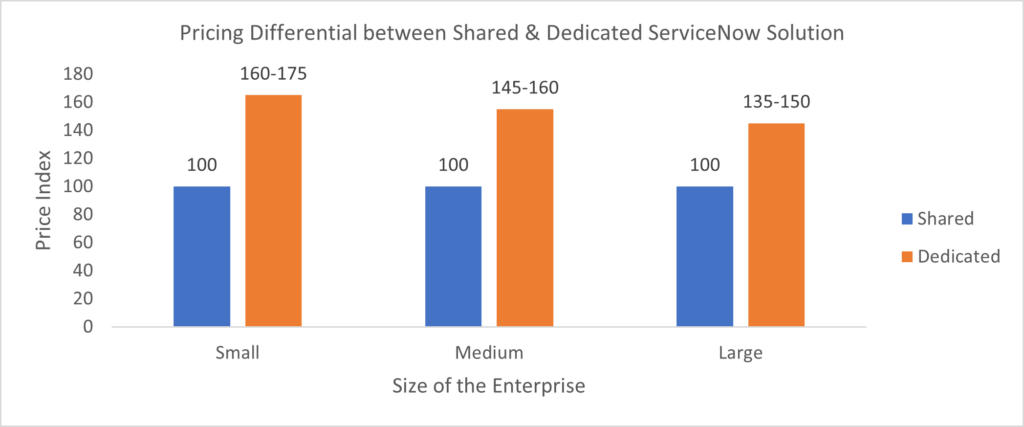Blog
Choosing the Right ServiceNow Model for your Organization: Comparing Shared and Dedicated Instances

Deciding betweenServiceNow’s dedicated and shared instances can be challenging for organizations. By comparing the options against seven key parameters ranging from organizational size and business process complexity to the cost of ownership and customization options, enterprises can make a well-informed decision. Continue reading to learn more. For assistance with benchmarking the ServiceNow implementation and managed services effort and price, contact us at [email protected].
In recent years, ServiceNow has significantly expanded its portfolio to move beyond IT Service Management (ITSM) and IT Operations Management (ITOM) to offer comprehensive enterprise solutions that help clients drive business growth, improve employee efficiency and productivity, increase resilience, and enhance customer experience.
The ServiceNow platform represents a major organizational cost that includes securing the platform license, initial implementation, and maintenance. As cost optimization becomes increasingly important, many enterprises considering ServiceNow adoption grapple with deciding between a dedicated instance model or a shared instance model to save cost.
To make an informed decision, let’s first understand what defines the shared instance and dedicated instance of ServiceNow. By comparing certain key parameters, organizations can choose the most suitable option.
- Shared instance here refers to the managed services provider’s (MSP’s) domain-separated ServiceNow offering. It is a multi-tenant environment that is shared among multiple customers of SP (Service Provider), with each customer having a separate domain of their own
- Dedicated instance implies a single-tenant environment used exclusively by one customer. This means that all the infrastructure resources, databases, and application processes are reserved solely for individual customer use
Based on our research and discussions with industry leaders, we recommend enterprises consider the following seven key parameters when evaluating which model to choose in adopting the ServiceNow platform:
| Key parameters | Shared instance | Dedicated instance |
| Organizational size | Better fit for small to mid-size organizations with simple and straightforward requirements | Large enterprises with varied requirements, needs, and complex operations benefit more from dedicated instance |
| Business process complexity | More suited for organizations that have simple workflows and are looking to implement basic ITSM processes like incident, problem, and change management | More ideal for organizations with complex workflows and ever-changing business processes and integration requirements |
| Total Cost of Ownership (TCO)
(Inclusive of licensing, implementation, ongoing maintenance, upgrades, etc.) |
Low TCO as the cost associated with setting up, maintaining, and managing domain separated instance is spread across multiple customers | Large enterprises with dedicated budgets for these initiatives usually prefer this higher TCO option |
| Customization and flexibility | Minimum customization is possible on shared instance as this is a standard one-size-fits-all offering from the MSP | Offers the highest level of flexibility, customization, and personalization tailored to the organization’s needs |
| Privacy, security, and compliance | Due to the shared nature of the instance, data segregation and protection measures need to be very well configured to achieve security and ensure privacy
|
Dedicated instance is solely for one enterprise, and the control elements are assigned to that enterprise alone
From a compliance point of view, enterprises operating in highly regulated industries usually prefer this model |
| Time to floor | This plug-and-play model allows enterprises to quickly onboard | Organizations can efficiently transition onto the ServiceNow platform, but making the platform live and operational takes some time |
| Scalability and future vision | Scalability can be limited for any particular enterprise as multiple customers share the same resources | It can easily be expanded to accommodate an enterprise’s changing user base, service offerings, and resource requirements |
Even though the shared instance model can cost 35-75% less (as shown below) based on our research, price should not be the only consideration when implementing a ServiceNow solution. Enterprises should consider all the parameters discussed and take a holistic view.

Many enterprises struggle with choosing between the shared or dedicated instance model, as both have their own set of advantages and drawbacks. While each organization has unique requirements, considering the key parameters outlined above will help enterprises select the best setup for their needs and move them in the right direction.
For a more detailed analysis and assistance with benchmarking the ServiceNow implementation and managed services effort and price, please reach out to [email protected].
Also, don’t miss our annual webinar, Key Issues 2024: Creating Accelerated Value in a Dynamic World, to learn the major concerns, expectations, and trends for 2024.